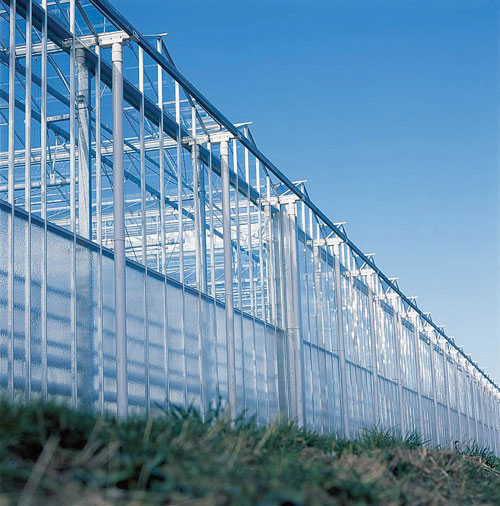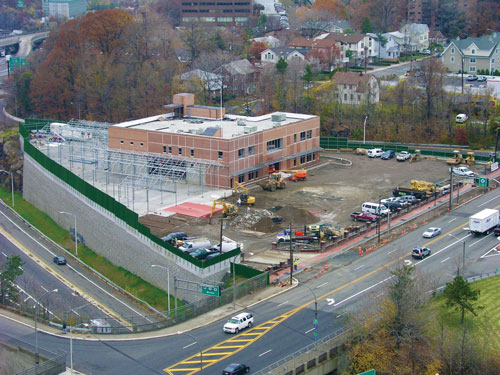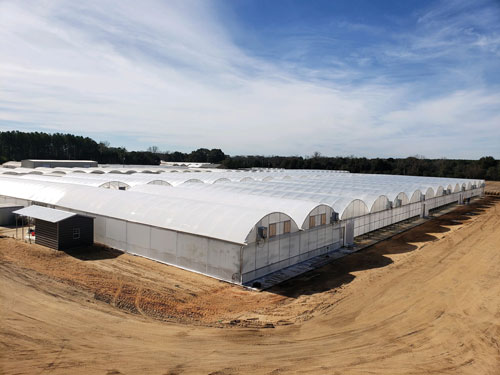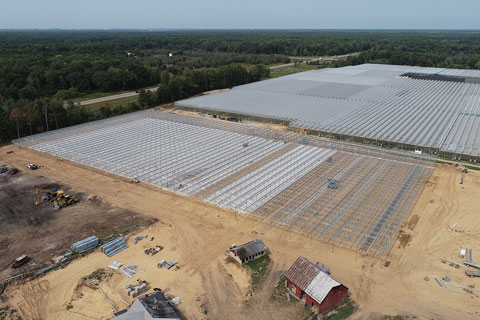4/1/2022
High Demand, High Prices, High Hopes
Jennifer Zurko

Pictutred: A Venlo greenhouse with a gable wall.
For the horticultural industry, the pandemic presented itself as a two-sided coin. On the one side was tragedy and significant disruption; on the other, sales windfalls amid high demand.
For greenhouse manufacturers, it’s the same story. On one hand, most of them have never experienced so much growth in such a short time. On the other, supply chain issues and high prices have prevented them from truly enjoying the moment.
Demand at a cost
“Unprecedented.”
“Phenomenal.”
“Crazy.”
Those are the words from some of the greenhouse folks who shared their thoughts on how business was during the pandemic. By now, everyone knows the story: People stayed home and wanted to garden, so the demand for plants and flowers went up. But those who grow and sell plants weren’t the only ones who were trying to keep their heads above water—other suppliers played a part in the efforts to ensure there was as much product as possible on racks and benches. Growing media, pot and tray suppliers, chemical companies—all of them had to handle increased demand with a revolving door of sick employees having to stay home for weeks at a time.
It was the same story for greenhouse manufacturers, too. As the coffers of growers and retailers began to grow, so did the requests for additional growing and/or retailing space.
Bill Mathis of Atlas said demand hasn’t slowed—they’re even taking orders right now for very large future projects. But the timing has surprised him.
“To be doing that this time of year in the horticulture market is pretty unusual,” explained Bill. “Here we are coming in to spring and they’ve got these building projects going on. Usually, they’re focused on making their money and doing what they do. Then they count their coins at the end of spring and we start talking about expansion projects.”
 Pictured: A new garden center under construction in New Jersey.
Pictured: A new garden center under construction in New Jersey.
There have been two other challenges added to the mix of increased demand for structures—rising prices and supply chain disruptions. Both of them intertwined to create a morass of long lead times for builds and exorbitant costs that, in many cases, the manufacturers had to absorb themselves.
"One of our manufacturers that we’ve worked with in the residential market, before the pandemic we were six weeks out, maybe eight weeks out on an order. And now we’re seven to eight months, sometimes even longer,” said Buzz Sierke of Gothic Arch. “And it has definitely impacted prices, which have just jumped.”
Bob Rimol, president of Rimol Greenhouse Systems, describes the increased demand as, “All of us were the beneficiaries of being in the right place at the right time.” But he’s quick to point out that the growth in sales has come with significant cost increases.
“Everybody knows that the cost of steel and aluminum has doubled and I feel like there’s a sense of urgency among our customers to purchase also because of the supply chain,” said Bob. “Are you going to get a greenhouse in a month or six months? People are still nervous about that.”
And it’s not just the parts that make up what I call “the skeleton” of the greenhouse that have been taking months—it’s all the different pieces that bring it together that have caused major delays with greenhouse builds.
“Those are things that I think all of us have had to deal with in the last year,” said Bob. “One week it might be aluminum, the next week it might be heaters—it just seems like there are so many curve balls being thrown at us.”
Other industries have been experiencing the same delays and cost increases, too, so everyone’s in the same boat (waiting to dock!). When you’re faced with issues like these, the only thing you can do is to keep your customers in the loop with transparency and an extra dose of great customer service.
“Growers are pretty reasonable,” said Bob. “No one wants a delay, but I think as long as you’re proactive in communicating then people get it.”
Sometimes a situation comes up where you have to be creative and every so often you “have to bite the bullet,” said Bob. “We’ve had to do that a couple of times, and it’s painful, but that’s how we do business.”
 Pictured: Pro-Com gutter-connect greenhouse from Atlas.
Pictured: Pro-Com gutter-connect greenhouse from Atlas.
Bob gave an example of one project where they were waiting for one extrusion for a ridge vent for a customer who needed three ridge vents on three brand new greenhouses. Bob said they eventually had to give them free poly, bypassing the ridge vent just so the grower could get them covered in time for the growing season. After their turns, Bob said they’ll go back and put on the original poly. The wait time was just too great and they needed to take care of their customer.
“That was a $5,000 bill—and, boy, that hurt—but I had to do what I had to do. It’s just one of those things,” said Bob.
What’s next?
Although we’ve been experiencing the inflationary pain of high demand, high costs and supply chain issues, greenhouse manufacturers are already seeing some evening out. But there’s still skepticism on whether it will ever be back to pre-pandemic numbers.
“We are finally on the back side of the curve of steel costs,” said Prospiant’s Burkhard Metzger. “They were being pushed upward for almost a year. We went from 40 cents a pound and topped out at $1.30 a pound. Will steel prices ever go all the way back down? Probably not.”
Paul Golden, sales manager for Prospiant, said, “For the near future, it appears that there is still more pent-up demand for steel and aluminum from industries like appliances and automobiles, which were prevented from manufacturing at full capacity over the past year.”
“Aluminum prices have not peaked yet,” said Burkhard. “There’s still a lot of pressure pushing prices to $3,300 a ton. It’s absolutely, totally off the charts. That’s more to do with energy pricing and transportation costs.”
Gordon Van Egmond, who’s been a U.S. sales rep for Westbrook Greenhouse Systems for over 26 years, said it’s hard to predict where costs will go as pandemic numbers continue to go down.
“Costs so far haven’t been moving much in the downward direction and I think they will never go back to pre-pandemic,” he said. “This may be the new norm and growers will definitely have to, if they haven’t already, look at their inputs and recalculate their sell prices.”
 Pictured: Westbrook Skyline II open-roof greenhouses with double poly covering make up a recent addition for Spring Meadow Nursery in Grand Haven, Michigan.
Pictured: Westbrook Skyline II open-roof greenhouses with double poly covering make up a recent addition for Spring Meadow Nursery in Grand Haven, Michigan.
Bob feels like the supply chain is “on the mend,” but it’s not just the parts for the structures we need to worry about. Disruptions in the fuel supply and the continuous labor shortage is a major concern as greenhouse manufacturers and the growers they service look ahead to expanding their businesses.
“We just finished going through the period of low-energy costs and I think energy costs are going to dramatically increase in the next five years,” said Bob. “One of the issues with electric is that we’re not building power plants in the United States and we need to because our demand keeps increasing, but our supply is not. So what do you do? Are more businesses going to invest in solar in order to off-set these costs? I just see the cost of propane, natural gas—everything—just really going up quite a bit in the next five years.”
At press time, the main topic on every news outlet and social media feed was about Russia’s invasion of Ukraine and how sanctions put in place to squeeze Russia economically have affected fuel prices around the U.S. and Europe. But oil isn’t the only product that will be affected by the invasion.
“Prices for tempered glass sheets went up a bit to $7.45 a square meter, but the cost has basically been flat,” said Burkhard. “Some of the European manufacturing capacity is located in the Ukraine where the Russian military recently invaded the border and separatists have declared independence in two regions. We have a weekly glass call where we talk about that. We don’t see price increases yet. But going out one month, if the Ukraine situation doesn’t get resolved or de-escalated, there’s going to be upward pressure on the glass supply globally.”
Burkhard explained that a prolonged conflict in Ukraine will most likely exert pressure on the Chinese glass market and the big cost with Chinese-made glass is transportation.
“A container used to cost $4,000 for shipping from China to the Eastern U.S. seaboard,” said Burkhard. “Today, that cost is $19,500 or $20,000. Shipping costs now exceed the value of the glass.”
“With the stability of the world economy in further jeopardy with Russia’s invasion, that’s going to exacerbate the negative impact that we’ve been dealing with—fuel prices going up, transportation, plastics—all of that’s going to be impacted,” said Buzz. “When you have disruption in the flow of oil and fuel, it makes you realize how vulnerable we are as a society.”
What types of structures are growers currently asking for and why?
Gordon Van Egmond, Westbrook: Most growers have been building our Skyline II open-roof houses and our Apex peak vented houses. Which model they build depends on the crop grown and their budget.
The Skyline II is a great house for all-year growing, especially if you want to harden off crops and/or grow into the summer months. This is a favorite for nurseries and perennial grows, but more and more annual growers use it as well.
The Apex peak vented or gutter vented is used predominantly for annual growers and is less expensive. The peak vent version of the Apex is fast becoming a favorite, as it vents at the top.
As for cladding, probably 75% are choosing double poly and the rest diffused glass. The decision to use either is based on several factors such as cost, property tax impact and crop. With most glass now coming from overseas and the cost of shipping, the cost spread between poly and glass is widening.
Paul Golden, Prospiant: In the retail garden center market, we’re seeing increased growth for garden and houseplants. More rural areas are being developed into urban communities with a large influx of new customers. To keep up with demand, more retail space or new retail sites are being built. Many retail operations are expanding their in-house production to control some of their supply of young plants or finished plants.
Wholesalers are building more propagation (highly automated, gutter-connected greenhouses) and finishing houses (gutter connects or ground-to-grounds) based on larger contracts with independent retailers or big-box stores.
Both retailers and wholesalers are increasing their production of nursery stock for use by landscapers and other new home contractors.
Then there’s demand for local produce that’s driving the development of regional, large-scale, automated, hydroponic greenhouse operations.
Bill Mathis, Atlas: One of our strengths is serving the large ornamental grower. We offer a lineup of engineered poly-covered gutter-connected structures that offer a cost-effective means of covering large square footage. These structures are typically naturally ventilated, which means lower operating costs. We have also experienced an increased demand for more automated, controlled environment structures for the hydroponic and aquaponic growers.
Bob Rimol, Rimol: It doesn’t really matter what they’re using a greenhouse for—the biggest thing is that people are now spending more money on bells and whistles to have more conveniences and more efficient greenhouses. People are opting for more, I wouldn’t call them luxuries, but upgrades.
The other piece of this is the labor situation is so bad right now that if people can find ways to become more efficient, they’re spending the money to do it. Existing growers are expanding and there are new people coming into the industry every day and they’re doing new builds. It’s definitely growth.
Buzz Sierke, Gothic Arch: Your mainstream greenhouse technology and crop production relies very heavily on your chemical fertilizers and growing systems, but I see a heavier demand for organic and natural production systems. That’s one of the things that jumps out. I have a lot of greenhouse customers wanting geothermal and solar now. They don’t want to rely on chemical-based energy systems and fertilizers. And for your hydroponics fertilizers there’s more and more demand for organic. It’s interesting to see the different innovative uses of greenhouse technology out there and that’s what’s exciting about it.
—JZ
Self-Assessment: Build New or Refresh?
In a recent Tech On Demand podcast, brought to you by GrowerTalks, we sat down with Prospiant’s sales manager for commercial greenhouses Paul Golden to discuss how greenhouse professionals should approach the decision to build new greenhouses versus retrofitting or repurposing existing structures to meet new crop needs or prepare for future product mix shifts.
In the episode, we covered many angles, from the physical structure and components under the roof to the people who work in your greenhouses every day. According to Paul, here are the key initial questions and some things you and your team need to consider before making this important decision:
Question 1: Do your structures have all the functionalities needed for the crops they’ll house or were they originally intended for a different use and need major overhauls?
• Are your greenhouses able to be retrofitted with modern equipment like shade curtains, basket lines and irrigation booms?
• Are your structures using energy-efficient glazings and heating systems?
Question 2: Are your current greenhouses efficient in terms of layout, design and equipment placement?
• Does the current layout allow for automation to move plant material, such as conveyors, palletized benching, trolleys and carts?
• Is production limited to single-tier or are your greenhouses built to allow for basket and flat or container production in the same space?
Question 3: Are your greenhouses comfortable and safe places to work? In today’s environment, facing labor challenges is a constant. The difference between attracting and retaining a good team has more to do with the workplace than ever before.
• Are your structures too “hard” or uncomfortable to work in all day?
• Are your greenhouses conducive to labor efficiency and product flow?
For the full episode, and more than 30 others, visit GrowerTalks.com/techondemand or subscribe to Tech On Demand on your favorite podcast app like Apple, Spotify, Google, Stitcher and more.
—Bill Calkins